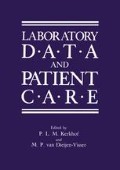Abstract
Early detection of new trends in repeated measures of monitored variables is important in at least three clinical decision tasks; in the early detection of disease, in the detection of disease recurrence following ablative therapy, and in status monitoring such as occurs in the intensive care setting. The goal in the first two instances is to detect deviations that indicate disease early while intervention can be most effective. By detecting trends or certain prototypical changes early, the goal of status monitoring is to predict progress or provide sufficient warning of adverse outcomes so that therapy can be appropriately adjusted in a timely manner.
Access this chapter
Tax calculation will be finalised at checkout
Purchases are for personal use only
Preview
Unable to display preview. Download preview PDF.
References
J.A. Blom, J.A.F. de Ruyter, N. Saranummi and J.E.W. Beneken, Detection of trends in monitored variables, in: “Computers and Control in Clinical Medicine”, E.R. Carson and D.G. Cramp, eds., Plenum Press, New York (1985).
D.P. Connelly and S.S. Rich, Detection of deviations in time series by the human observer, in: “Proc. IMIA Workshop on Maintaining a Healthy State Within the Individual”, (in press).
D.B. Beard and C.M. Haskell, Carcinoembryonic antigen in breast cancer, Am. J. Med. 80: 241 (1986).
P. Winkel, M.V. Bentzon, B.E. Statland, et al., Predicting recurrence in patients with breast cancer from cumulative laboratory results: A new technique for the application of time series analysis, Clin. Chem. 28: 2057 (1982).
K.A. Ericsson and H.A. Simon, eds., “Protocol Analysis Verbal Reports as Data”, MIT Press, Cambridge, MA (1984).
E.K. Harris, Some theory of reference values. II. Comparison of some statistical models of intraindividual variations in blood constituents, Clin. Chem. 22: 1343 (1976).
Author information
Authors and Affiliations
Editor information
Editors and Affiliations
Rights and permissions
Copyright information
© 1988 Plenum Press, New York
About this chapter
Cite this chapter
Connelly, D.P., Rhodes, J.B. (1988). Decision Making in Clinical Monitoring: Experts, Expert Systems and Statistics. In: Kerkhof, P.L.M., van Dieijen-Visser, M.P. (eds) Laboratory Data and Patient Care. Springer, Boston, MA. https://doi.org/10.1007/978-1-4757-0351-1_23
Download citation
DOI: https://doi.org/10.1007/978-1-4757-0351-1_23
Publisher Name: Springer, Boston, MA
Print ISBN: 978-1-4757-0353-5
Online ISBN: 978-1-4757-0351-1
eBook Packages: Springer Book Archive

